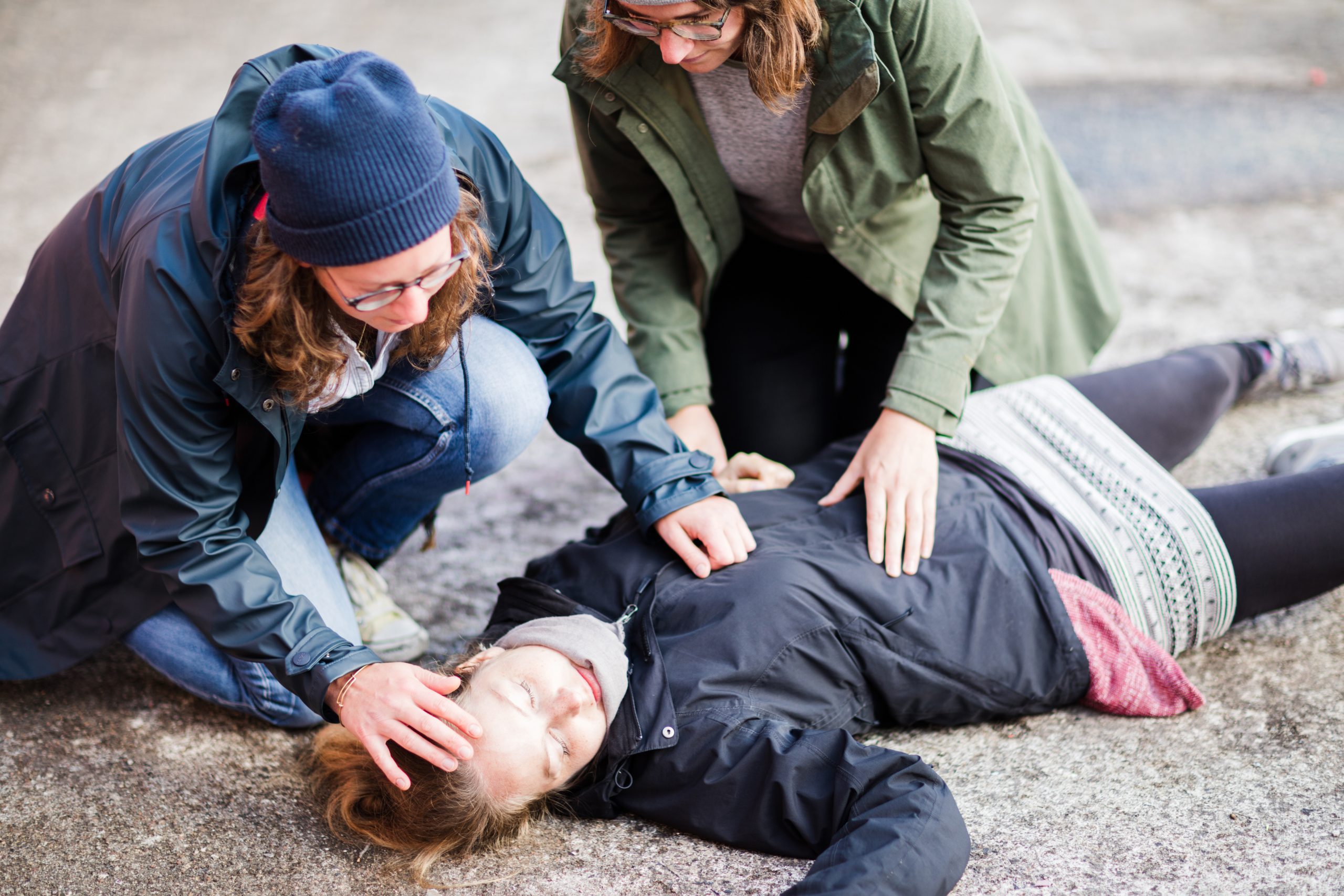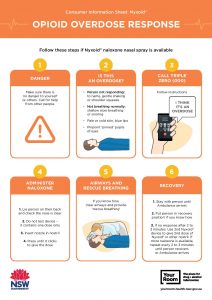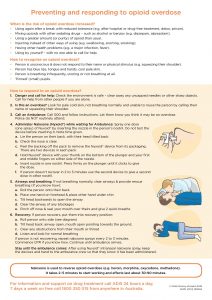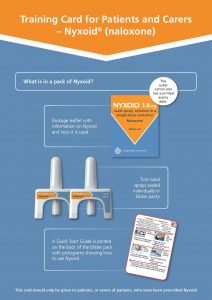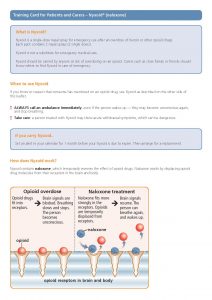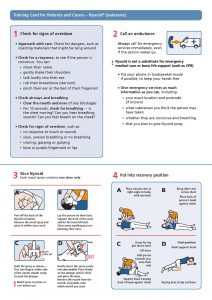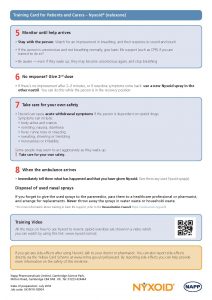Fresh Therapeutics Is A Trial Site For The Australian Government Take Home Naloxone Pilot
Take Home Naloxone Pilot
The Australian Government is investing $10 million in a take-home naloxone (THN) pilot in New South Wales, South Australia, and Western Australia. This pilot is commencing on 1st December 2020 and will continue until the 28th February 2021.
What is Naloxone?
Naloxone is a drug that reverses the effects of an opiate and can therefore reverse an opioid overdose. It can be injected or delivered through a nasal spray. In the THN pilot, naloxone (as either Naloxone Hydrochloride (DBL), Naloxone Juno, Nyxoid and Prenoxad) will be available for FREE to people who are at risk of, or who may witness, an opioid overdose. No prescription will be required for the drug.
How does Naloxone work?
Naloxone reverses the effects of opioid drugs, albeit temporarily. This works by displacing the opioid molecules already within the person’s system in the brain and body. During an opioid overdose, drugs fit into receptors and brain signals are therefore blocked. This leads to a slowing or complete failure in breathing. The person may then fall unconscious. However, once naloxone is administered, it fits more strongly into the receptors within the brain and body causing the opioid molecules to be displaced for a time. The brain signals can then resume as normal, breathing will continue, and the person should then regain consciousness.
What to do if you carry Naloxone with you?
Carrying naloxone with you regularly is always a good idea if you are an opioid user, or if you are regularly around an opioid user. This could be a family member, spouse, close friend, etc. Ensuring that you are stocked on naloxone that is in date is imperative, in case you ever need to administer it. You should set a reminder on your calendar or phone around one month before the naloxone is set to expire. This will give you enough time to arrange for and pick up a replacement.
When do you use Naloxone?
If you know for a fact that someone has overdosed from an opioid drug, then you should administer naloxone. Even if you only suspect they have done so, it should also be used. You should also remember to call an ambulance as quickly as possible. If there are two of you there with the person, one of you should administer while the other calls the emergency services. Even if the person wakes up, you should still call the ambulance, as they could fall unconscious again at any moment. However, always be aware of your own surroundings, stay safe, and keep in mind that they may be aggressive if they do regain consciousness.
Why is this trial happening?
Unfortunately, throughout Australia, Opioid use is a major cause of both hospitalisation and death. Therefore, the Australian government has now decided to make an active change in order to treat and improve the issue. The following statistics outline just how serious the problem is in this part of the world:
- Every single day, three people die from drug-induced deaths involving opioid use in Australia, while nearly 150 hospitalisations and 14 emergency department admissions involve opioids across the country.
- More than 110,000 Australians are currently struggling with opioid dependence.
- In 2018, 1,740 people died from drug-induced deaths, with opioids present in 1,123 of those deaths (64%).
At Fresh Therapeutics Compounding Pharmacy, we will be offering Naloxone FREE of charge to people prescribed opiates, people that use illicit opiates or people who may witness a person overdosing on opiates. As well as this, we will also be providing clean needles from our needle exchange to those who inject opiates.
If you are not sure if a drug you or a family member is taking is an opiate, ask our pharmacists or call us on 0292816816
What is an opioid overdose or adverse reaction to opiates?
A person who has taken either a large amount of opioids or some strong opioids can overdose or experience an adverse reaction. They may be:
- unconscious
- unresponsive
- awake, but unable to talk
- vomiting
- making choking sounds, or a snore-like gurgling noise
They may also have:
- stopped breathing or have slow, shallow or erratic breathing
- bluish-purple skin (in lighter-skinned people) or greyish or ashen skin (for darker-skinned people)
- a limp body
- a pale or clammy face
- blue or purplish black fingernails and lips
- slow, erratic or no pulse (heartbeat)
If someone at risk is making unfamiliar sounds while ‘sleeping’, try to wake them up in case they have overdosed.
Who is at risk of an opioid overdose or adverse reaction to opiates?
People who are dependent on opioids are at higher risk of an overdose if their tolerance to the drug is reduced. This can happen if they stop taking opioids for a while (for example if they have been in drug rehabilitation or in prison).
Other risk factors include:
- using opioids in high doses with other sedatives — for example, benzodiazepines,
- some medical conditions — for example
- depression
- HIV
- liver disease
- sleep apnoea
- lung diseases, such as chronic obstructive pulmonary disease or pneumonia
- living in a home where opioids are stored
What to do if you witness a person having an opiate overdose?
If you witness someone having an opiate overdose this is what you do:
1. Check for signs of overdose
Approach with care. Check for dangers, such as injecting materials that might be lying around
Check for a response, to see if the person is conscious. You can:
- shout their name
- gently shake their shoulders
- talk loudly into their ear
- rub their breastbone (sternum)
- pinch their ear or the bed of their fingernail
Check airways and breathing
Clear the mouth and nose of any blockages
For 10 seconds, check for breathing — is the chest moving? Can you hear breathing sounds? Can you feel breath on the cheek?
Check for signs of overdose, such as:
- no response to touch or sounds
- slow, uneven breathing or no breathing
- snoring, gasping or gulping
- blue or purple fingernails or lips
2. Call Emergency Services ‘000’
- Always call for emergency services immediately, even if the person wakes up.
NALOXONE is not a substitute for emergency medical care or basic life support (such as CPR).
Put your phone in loudspeaker mode if possible, in order to keep your hands free.
Give emergency services as much information as you can, including:
- your exact location and postcode (if known)
- what substances you think the person may have taken
- whether they are conscious and breathing
- that you plan to give Naloxone
3. Administer Naloxone
Our pharmacist will show you how to administer the Spray or Injection. Peel off the back of the container before taking out the spray itself. With the person lying flat on their back, support the back of their neck and tilt the head back. Remove anything that is visibly blocking their nose. Hold the spray with a finger on either side of the nozzle and your thumb on the bottom of the plunger. Never press it before use. You do not need to test it or prime it. Insert the nozzle of the spray bottle into one nostril, it does not matter which you choose. Press the plunger until you hear a click sound, this will tell you that all of the dose within the bottle has been administered. Take the nozzle away from the nostril. Remember which nostril you administered into in case you need to re-administer into the second nostril later.
Alternatively, you can watch these handy videos:
Nasal Spray: https://www.medicines.org.uk/emc/product/9292/video
Injection: https://www.youtube.com/watch?v=pXebC1rLsqw
4. Put the person into the recovery position
Putting someone in the recovery position can improve their condition until the emergency services arrive. However, we appreciate that many people do not know exactly how to put an unconscious person into this position. Place the person’s nearest arm up at a right angle to their body, in a bent position. Then pull their far arm across their chest, placing the back of their hand against their opposite cheek. Get hold of their furthest leg above the knee, lift it, and roll them towards you until they are on their side. Then use their hand to support their head and bend their top leg at the hip and knee.
CALL our pharmacists at Fresh Therapeutics for more information
5. Monitor until help arrives
Stay alongside the person and monitor their breathing, watching for any signs of improvement. Also, monitor their ability to respond to your sound and your touch.
If the person in question is not conscious, nor breathing normally, then now is the time to administer basic life support, but only if you are trained to do so. This includes things such as CPR.
The most important thing is to constantly be aware. Even if the person wakes up, that is no reason to let your guard down, as they could easily fall unconscious and stop breathing again.
6. What to do if there is no response
If you have gone through the above five steps and there has been no improvement after two or three minutes, or the symptoms return, use a brand new spray in the next nostril. Keep the person in the recovery position while you do this.
7. Remember your own safety
If the person in question is dependent on opioid drugs, you must be careful of the acute withdrawal symptoms that some sprays may cause. If and when a person regains consciousness after using the spray, they may act with aggression for a period of time. Keeping your own safety in mind is always imperative. Symptoms of acute withdrawal can include things such as nervousness, irritability, sweating, shivering, runny nose, fever, sneezing, nausea, vomiting, diarrhoea, aches, cramps, and more.
8. What to do once the ambulance
The first thing you should do is inform a member of the emergency services that you have administered a spray, before telling them which spray it is and handing them a sample bottle of it. If you forget to do the above, you should still hand the used bottles over to a pharmacist or healthcare professional in order to arrange proper disposal and replacements. Never put the sprays into water waste. Never throw the spray bottles in with your household waste or recycling.

